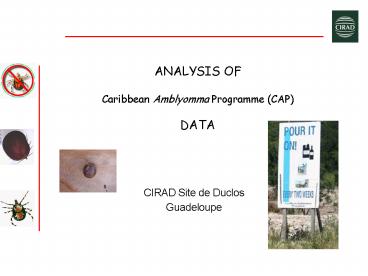ANALYSIS OF Caribbean Amblyomma Programme CAP DATA - PowerPoint PPT Presentation
1 / 23
Title:
ANALYSIS OF Caribbean Amblyomma Programme CAP DATA
Description:
Host specie. Management and production. Type of production (milk, meat) ... Ticks (gender, host specie) Dermatophilosis. Methods. I - REVIEW QUALITY OF DATA ... – PowerPoint PPT presentation
Number of Views:76
Avg rating:3.0/5.0
Title: ANALYSIS OF Caribbean Amblyomma Programme CAP DATA
1
ANALYSIS OFCaribbean Amblyomma Programme
(CAP)DATA
- CIRAD Site de Duclos
- Guadeloupe
2
Introduction
- CAP eradication of Amblyomma variegatum (TBT)
- Field activities starting date 1995
- Change in the programme 2007
- Assess eradication activities efficacy
- ? Foresee the consequences of ending eradication
activities risk analysis based on
epidemiological data collected during 10 years
3
- Background
- Presence of TBT in the Carribean
- CAP
- - Detailed objectives
- Materials et methods
- First results
- Nevis
- Discussion and perspectives
4
- Background
5
Amblyomma variegatumTropical Bont Tick
- Brought during the 18th century
- Spread throughout the Caribbean
- Vector of cowdriosis
- Associated to dermatophilosis
Threat to livestock production development
Risk of spread to Americain mainland
6
Carribean Amblyomma Programme
CAP International programme Starting date
1994 Fundings USDA, FAO, UE, IICA Lesser
Antilles
- Treatment
- ? Bayticol
- Break the reproduction cycle by treating every 2
weeks - During 2 years
2) Monitoring and surveillance Examination of
animals in randomly chosen farms every quarter
Collection of surveillance data in TickInfo
7
Objectives of analysis
- Correlations
- Treatment
- Host specie
- ? Management and production
- Type of production (milk, meat)
- Stray animals, fenced farms, mixed population,
herd size - Quarter
- Environment
- Climat, vegetation, landuse, humidity
- gtbiomes
- gt Geographical analysis (GIS)
Assess eradication activities efficacy Did the
prevalence decreased ?
Recommendations Increase control/surveillance
activities effectiveness
Risk analysis Consequences of changes in CAP
activities
8
Materials and methods
9
Materials TickInfo
Available informations Visit date Farm location
(province, farm) and contact ID Treatment
Animals in visited farm Examined animals Ticks
(gender, host specie) Dermatophilosis
St Kitts, Nevis, St Lucia, Barbados Dominique,
Antigua Other island qualitive analysis
10
Methods
- I - REVIEW QUALITY OF DATA
- II - REVIEW QUANTITY OF DATA COLLECTED AMONG
THE SURVEILLANCE PERIOD - III - EVOLUTION OF ANIMAL/FARM PREVALENCE
AMONG THE PERIOD - IV - CORRELATION WITH PARAMETERS AVAILABLE
R
11
Results
12
Results Nevis
13
Results
I - REVIEW QUALITY OF SURVEILLANCE DATA
- 1) Errors in data
- Examined animals gt Animals in visited farm
- Positive farm without any animal registered
- Nevis 0.4 visits Barbados 1.6
- 2) Surveillance procedure not properly followed
- 2 visits by quarter in the same farm and
different data collected on animals - gt Duplicates Nevis 10 visits Barbados 8
- 3) Unavailable informations
- Treatment status, farm location (GPS)
- Livestock data no recent census gtno
denominator - Information never collected in TickInfo data on
management and production
14
Results Nevis
II - REVIEW QUANTITY OF SURVEILLANCE DATAFARM
AND ANIMAL LEVEL
FARM
ANIMAL
15
Results (2) Nevis
II - REVIEW QUANTITY OF SURVEILLANCE DATA ANIMAL
LEVEL
16
Results Nevis
III - EVOLUTION OF PREVALENCE TICK LEVEL
17
Results Nevis
III - EVOLUTION OF PREVALENCE FARM ANIMAL
LEVEL
18
Results Nevis
III - EVOLUTION OF PREVALENCE FARM ANIMAL
LEVEL
19
Results Nevis
IV - CORRELATION WITH PARAMETERS AVAILABLE
Year Quarter Host specie Parish
20
Discussion and perspectives
21
Errors in data ?
Set of data
- Send an error file to countries for correction
- Data not Corrected and duplicates delete /
conserve them
Ask for information about herd management for
positive farms Livestock census estimation
from CVOs GIS data maps of climate, vegetation
n databases
n analysis
n results
Compare indicators
Influence of erratic data on results
22
Perspectives
- RISK FACTORS
- Modelise tick population evolution in the
Carribean - Population genetic study (time and geographical
evolution) - Pathogen population and genetic dynamique
23
Bilan
- Correlations
- Treatment
- Host specie
- ? Management and production
- Type of production (milk, meat)
- Stray animals, fenced farms, mixed population,
herd size - Quarter
- Environment
- Climat, vegetation, landuse, humidity
- gtecozones
- gt Geographical analysis (GIS)
Assess eradication activities efficacy Did the
prevalence decreased ?
Recommendations Increase control/surveillance
activities efficacy
Risk analysis Consequences of ending CAP
activities































